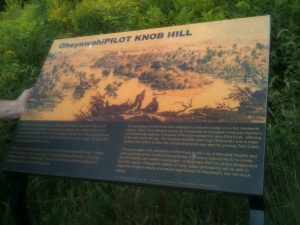Originally published on Planning 101, the MAPC blog, on December 1, 2011, in my capacity as an MAPC Senior Regional Planner.1
Are there certain places that should never be built upon?
This is a question I’ve been grappling with, as a planner and as an American, since visiting a sacred burial ground in the Midwest during a professional conference this summer.
In August I attended the National Scenic Byways Conference in Minneapolis, where I participated in a half-day field workshop that explored approaches to interpreting American Indian history. It challenged participants to engage American Indians in their planning and development work.
Shortly after our bus arrived at Indian Mounds Park in St. Paul, a Dakota gentleman named Dave Larsen began the workshop by singing, invoking his ancestors, and sprinkling tobacco as a sacred offering to the earth.

It was a sunny, late summer day, and the park was abuzz with visitors bicycling and jogging on the trails. Situated on a bluff with views of the Twin Cities skyline, the park lies alongside to the Great River Road National Scenic Byway, which is a multi-state system of roads tracing the course of the Mississippi River.
He pointed to a park sign explaining the significance of the Indian Burial Mounds in this park. The Indian Mounds are depicted as distant historic artifacts, relics of the past that have no relation to the people of today other than occupying a space where locals recreate and enjoy the scenery.
Cheryl Cloud, Tribal Liaison for the America’s Byways Resource Center, reflected on the insensitivity of the signage. “It’s so hard to come here,” she said. “To a park where your ancestors are buried.”
I thought about cemeteries I’d visited. Many offer a wonderfully serene respite from the bustle of city life. I have fond memories of going for leisurely walks with a friend in a Philadelphia cemetery near where I lived during graduate school. I remember seeing joggers there, too. And I couldn’t help but wonder: was being there for a purpose other than mourning wrong?
Parts of the subdivison I grew up in were rumored to be built on native burialgrounds. I never knew how to feel about this. Disregarding the past is callous, but at the same time, does that mean certain places should never be built upon?
On Sept. 16, 2011, I visited the Sept. 11 Memorial in Manhattan. I thought it was beautifully crafted, and I think I’m among the supporters of the planned 105-story One World Trade Center building which will one day tower over the memorial site.
Visiting the site reminded me of the burial mound tour and I started to wonder whether those who were opposed to building on Ground Zero had a point. Was that entire footprint hallowed ground that should never be built upon?
As I walked around the memorial, I realized that I might be walking atop the remains of people who jumped from those buildings or who were burned alived while stuck inside. Many that day did not receive – or give – a proper goodbye to loved ones, colleagues and friends.

Steps away from my office in Downtown Boston, our Founding Fathers and other Colonists are buried. Why do these burial grounds in Boston and the Sept. 11 Memorial in New York City seem so different from the burial mounds at Indian Mounds Park in St. Paul? I think part of the difference is that I view the Founding Fathers as my own ancestors, even though that’s patently absurd.
My parents emigrated to the United States from India in the 1970s, but I was born in the United States and grew up learning about “my” Founding Fathers – the same Colonists buried on Copp’s Hill and at Old South Church. Equally inexplicably, I often feel deep mourning when I think about the victims of Sept. 11, though I did not know anyone victimized that day personally.
A sign like the one at Indian Mounds Park exemplifies how I, and presumably countless other Americans, have been conditioned to think about the Native Indian population as archaeological subjects to be studied, and not as members of our ancestry and heritage in the same vein as our Founding Fathers – and, I would argue, those killed by terrorists on Sept. 11.
I think planners could make meaningful, significant progress in engaging communities and making all areas welcoming if we work to think about all ancestors of this land as our own, and all communities – whether or not they look like us – as kin.
